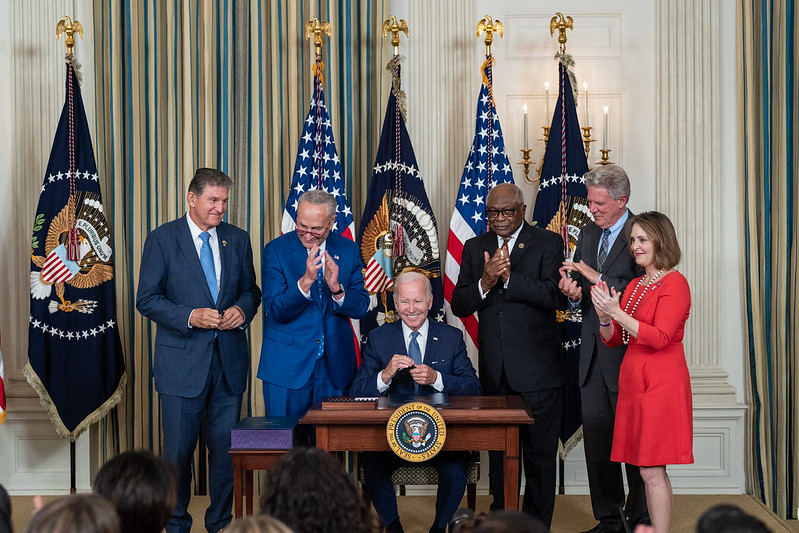
Don’t believe the strange backlash that has emerged this week: President Biden’s industrial policy has significantly boosted the growth of manufacturing construction, and we need to keep up this momentum.
On Monday, the Financial Times Long Report This article examines the status of various factory construction projects announced with funding from the Inflation and Recovery Act (IRA) and the CHIPS and Science Act. Along with the Bipartisan Infrastructure Act, these two pieces of legislation are emblematic of the industrial policy advanced by the Biden Administration through what it calls its “Invest in America Agenda,” and according to a new report: Business investment: $898 billion.
Oddly, the Financial Times laid out a rather pessimistic framing in its article, noting in its headline that 40% of major IRA projects are delayed and casting doubt on the feasibility of Biden’s entire industrial policy. Most of the IRA projects are progressing smoothly and some are already operational.It also fails to take into account that construction projects often face delays, as Jonas Nahm, an associate professor at the Johns Hopkins School of Advanced International Studies, pointed out on X (formerly Twitter).
Indeed, anyone who has undertaken a home improvement project, much less built a solar panel manufacturing facility from the ground up, knows that such projects will encounter delays. As Nahm points out, most importantly, the majority of IRA-funded projects are still underway, and there is still plenty of funding to be allocated to further ramp up production.
Indeed, one of the biggest obstacles so far to the Biden administration’s industrial policy has been granting the funds and other incentives provided for in these laws. “Of the $1.1 trillion in federal infrastructure and pandemic relief spending since Biden took office, $125 billion By April of this year it was gone.” write Kate Aronoff of The New Republic.
But this isn’t surprising: It takes time for a company to find a suitable location for a new project of this magnitude, and all the other steps needed to get a shovel in the ground. High interest rates aren’t helping, either. It affected the entire manufacturing industry.Despite the ongoing construction boom, factory employment remains stagnant.
Yet when lawmakers introduced the IRA and other industrial policies, they knew they were playing a long game. This is a generational effort.
“The nation’s energy mix will not change overnight, the factories for all the equipment needed for that transition will not be built overnight, and consumers will not choose to upgrade to green technologies overnight. That’s why the programs in this bill are designed to take effect over at least a decade.” write David Dayen of “American Prospect.”
But while there’s still much to be done, much has already been done: Aronoff reports that the IRA, CHIPS and Science Act alone have provided “roughly $400 billion to build a domestic clean energy and semiconductor industry,” and the White House says there has been $395 billion in private investment in semiconductors and electronics. Private investment: $81 billion Since President Biden took office in January 2021, the clean energy sector has seen a surge in electric vehicles, batteries, clean power, and other industries. Over $898 billion.
And projects are being announced all the time. On Friday, the Biden administration Texas Instruments awarded $1.6 billion in grant funding Through CHIPS and the Science Act, it will build three new facilities, two in the Lone Star State and one in Utah. A week ago, it was announced that SK Hynix would receive a grant of up to $450 million to build a new chip factory in Indiana. This means that all of the world’s top five semiconductor manufacturers are investing. In the United States.
IRAs also continue to promote investment. The Biden administration announced in July $4.3 billion in grants for projects across the countryFor example, the United Steelworkers (USW) union said on Friday They signed a trade union neutrality agreement Partnered with solar power manufacturer Convalt Energy.
“From the production of solar cells, modules and panels to the installation, maintenance and repair of solar energy equipment, American-made solutions are needed to build domestic solar manufacturing capacity,” said Dave McCall, USW International President. “We look forward to working with employers like Comvalt to ensure long-term success across the sector.”
This is one of those moments when it’s important to take a step back. When I first joined the Federation of American Manufacturing in 2014, there was little reason to believe that the United States would implement policies to grow any critical industry, much less several at the same time. Much of our work was focused on shoring up factories that had managed to hang on for decades, under the mistaken belief that offshoring should be prioritized, even if it meant the loss of millions of good-paying, unionized American jobs.
The massive supply chain shortfalls caused by the COVID-19 pandemic have woken up many U.S. policymakers to the fact that they have too much manufacturing overseas. The ability to produce what we need must be paramount, especially in the critical industries like energy and semiconductors that are needed to make nearly everything these days.
The fact that the United States is now prioritizing domestic manufacturing, and that many of the new jobs created as a result are likely to be union-represented, is quite a change of mood.
The key now is to follow through. The U.S. has been closing factories and moving production overseas for decades. It will take more than a few years to get everything back on track. Delays on a few construction projects are no reason to give up.
Instead, the United States should move beyond IRAs, CHIPS, and other incentive-focused programs and focus on what we can do to strengthen domestic manufacturing capacity.
The key point is trade enforcement. Countries such as China remain dominant in global industries and are intent on putting American manufacturers out of business. The United States should not hesitate to enforce its trade laws, and policymakers must enact new laws that: Level the Playing Field 2.0creates new, modern tools to make it easier to take on some of the most egregious trade fraudsters. Restoring Section 421 import surge protection is another must-have to address the “market disruption” caused by import surges caused by China’s massive overcapacity in various sectors. Leveraging additional remedies such as Sections 301 and 232 would also be beneficial.
It’s been exactly two years since Biden signed the IRA bill, and it’s fair to say the IRA has been a success. Now we need to follow through on all these projects and put policies in place to ensure their continued success.






